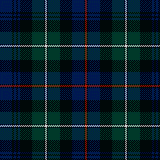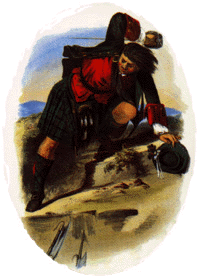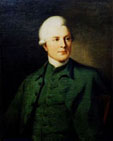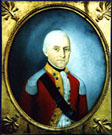Clan Mackenzie

The Beginnings
There is a tradition, not borne out, however by any tangible evidence or confirmation, that this very ancient family deduced its descent from a member of the House of Geraldine, in Ireland (whence sprang the noble families of Leinster, Desmond, &c.), who, with a considerable number of his followers, is stated to have settled in Scotland about the year 1261, and to have so powerfully aided King Alexander III, a few years afterwards, in repelling the invasion of Haco, King of Norway, that he was rewarded by a grant of the lands of Kintail, in the County of Ross, which were erected into a free Barony by charter, dated 9th January 1266. Therefore Colin Fitzgerald was the first feudal Baron of Kintail.His grandson who in the Gaelic was called Coinneach MacCoinneach (Kenneth son of Kenneth), 3rd Baron of Kintail, became corrupted in English into Mackenzie (pronounced: MacKenny) and hence arose all the families of Mackenzie in Scotland. The name "Mackenzie" therefore coming from the Gaelic: "MacCoinneach" meaning: "Son of the Fair One".
Examining records that suggest a descent from the Earls of Ross indicate that such a descent existed through Margaret, the wife of Kenneth A'Blair Mackenzie VIII Baron of Kintail, she was the daughter of John IV Lord of the Isles and Earl of Ross.
The Clan Mackenzie
The fate of the Clan Mackenzie was famously foretold by the Brahan Seer (Brahan, near Dingwall, was where the castle stood until it was demolished in 1951). Having risen in power an influence to hold lands which stretched right across Scotland, and to become one of the four most important Highland Chiefs in 1726 (the others were the Dukes of Argyll, Atholl and Gordon), Lord Seaforth's line ended in the 19th century when all four of his sons died before him.
Mackenzie Tartan,
Modern Colours.
Alasdair Mackenzie 7th chief, who died 1488, was the most prominent supporter of the Crown against the all powerful Lord of the Isles and got his reward in forfeited MacDonald lands. Originally in Kintail around Loch Duich with Eilean Donan Castle as their base, they spread throughout Ross-shire, and into Lewis on the Outer Hebrides. They moved their seat to Kinellan near Strathpeffer, before building Brahan Castle.

Mackenzie Clansman by McIan,
probably a portrayal of a young
Alexander "Ionraic" Mackenzie
It was the Mackenzies' loyalty to the Stewart Kings which brought about their downfall. Kenneth 4th Earl one of the first Knights of the Thistle, the Scottish Order of Chivalry, followed James VII exile at the end of the 17th century, the time when the Brahan Seer predicted doom for the house. The 5th Earl raised an army of 3000 men in 1715 for the Jacobite Pretender, and had to flee to France, returning in 1719 to be severely wounded at Glenshiel. Several Mackenzies took part in 1745 rebellion.

Colin Mackenzie of
Scatwell (1746 - 1814)
grandfather of Major
James D. Mackenzie
Findon (author of The
Findon Tables)

Sir James Wemyss
Mackenzie (1775 - 1843)
5th Baronet of Scatwell

Colonel George
Mackenzie
(1775 - 1840)
The Findon Tables
The Findon Tables were published by Major James D. Mackenzie of Findon in 1879. Much of the research being carried out by his brother Lewis Mark Mackenzie nearly thirty years earlier who died early in life. Major Mackenzie took it upon himself to complete most of the work and present the mass of information in the form of "Family Trees," or "Tables," showing the origin of different branches, their progression and relation to each other.
The top of Findon Table sheet number 2, showing the descendants of Alexander Ionraic Mackenzie
The Tables
There are twelve main sheets, a supplementary sheet and a booklet. Sheet 1 gives the "Main Stem" of the Kintail, Seaforth and Cromartie families, with the details of their immediate offshoots. The other eleven main sheets look more closely at the individual families that branched off from the main stem, with their cadets. The supplementary sheet gives the descent of some ancient families deriving from the early rulers of the country where the possessions of Clan Kenneth afterwards became fixed, and with whom it was connected by marriage ties. The 24 page booklet gives an introduction by Major James D. Mackenzie of Findon and extensive notes about the tables with References, a list of Kintail or Seaforth Charters and an index of families and names.The first sheet begins with "John de Comyn (red), Lord of Badenoch, d. 1273", "King John of England", "Colin or Cailean, the 'Gerald' of tradition, or of early Celtic or Irish Derivation" (the earliest direct male ancestor of the Mackenzie line, in the tables), "Sommerled, Thane of Ergadia, slain 1164", "David I, King of Scotland" and "King Olaus IV, or Olave, 'The Red,' King of Man." The original tables follow the lineages of the main branches and cadet families up to circa 1878.

Clan Mackenzie of Seaforth
Clan Mackenzie of Seaforth badge incorporating the crest of a Rock in Flames with the motto: "Luceo non Uro" meaning "I shine not burn". Sir Roderick Mackenzie, Knight of Tarbat (2nd son of Colin Mackenzie, of Kintail; brother of Kenneth, 1st Lord Mackenzie of Kintail; and ancestor to the Earls of Cromarty and Cromartie) married (contract: 6 May 1605) Margaret, daughter and heir of Torquil Macleod of the Lewes, and thereupon added to his armorial bearing the achievement of Macleod. Thus when the chiefship of the Clan Mackenzie came into the hands of the Earls of Cromartie the crest of the new chief became the new Clan Mackenzie Badge.

Below the badge a water colour of
Eilean Donan Castle and the Mackenzie
Ancient colours tartan in the background.
Mackenzie of Kintail / Seaforth Highlanders Badge
Incorporating the original Mackenzie crest of a Stag's Head with the motto: "Cuidich 'N Righ" meaning "Help the King". The motto and stag's head come from the heroic rescue of King Alexander III by Colin MacCoinneach in 1263 who saved the king from a charging stag by shooting it dead with an arrow. For this deed and for his victory at the battle of Largs against the Danes in 1263, he was awarded the lands of Kintail, the free Barony of Kintail, the arms of a golden stag's head with a trickle of blood from between its eyes on a blue background and the right to be the hereditary Royal body guard (a tradition that was upheld until the battle of Pinkie in 1547).

